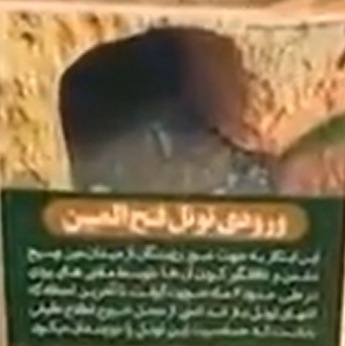Terms & Concepts
Fath al-Mubin Tunnel
Mohsen Shirmuhammad
Translated by: Hadi Qorbanyar
72 Views
The Fath al-Mubin Tunnel is built in western Dezful by the 21st Hamzeh Division (Army). Dug in 1981 by a qanat specialist from Meybod, Yazd, the tunnel was named “Yazd Project”.[1] It played an important role in Operation Fath al-Mubin.
There was a handle-shape water canal about three kilometers ahead of the Karkheh Bridge, along the Karkheh River, which was occupied by the Iraqis in the early days of the imposed war. The 1st Brigade of the 21st Hamzeh Division launched an attack to retake this canal, but suffered heavy casualties and, on the orders of Brigadier General Valiollah Fallahi (Chief of the Joint Staff of the Army), pulled back.[2] Then, the 1st Company of the 131st Battalion of the 1st Brigade, 21st Division,[3] was deployed to the area near the Karkheh Bridge in a place called Deh Hussainabad, which was about one kilometer away from the bridge. The enemy was positioned about 300 to 400 meters further ahead, in the handle-shaped canal (an irrigation canal) that was three meters deep. The Iraqis had direct tank fire covering a wide area behind Iranian’s lines, watching all movement and vehicle traffic.
To retake the canal, several limited attacks were carried out, including a small operation on April 4, 1981.[4] However, the enemy had laid down many obstacles, including minefields and explosives, to block the road.[5] Because the area was so critical, they also brought in fresh troops and fought with full strength to prevent Iran from taking the canal.[6]
After Brigadier General Valiollah Fallahi (Chief of the Joint Staff of the Army)[7] and Brigadier General Ghasem-Ali Zahirnejad (Commander of the Army Ground Forces) visited the area, they proposed digging an underground tunnel (beneath the minefield).[8]
In late August and early September 1981,[9] Haj Gholam-Hussain Raeiyat Roknabadi Hojjati (who was martyred in Operation Ramazan), from Roknabad, Meybod, Yazd, together with a group of qanat diggers from Yazd who had been introduced by Ayatollah Muhammad Sadouqi, the Imam of Friday Prayer of Yazd, started digging the tunnel.[10] By the help of Captain Muhammad-Kazem Mirhussaini from the artillery unit of the 21st Hamzeh Division, along with 15 Basij, Islamic Revolutionary Guard Corps (IRGC), and Army members, the digging started from the closest point to the enemy. The tunnel was about 170 cm high, one meter wide, and its ceiling thickness was around 2 to 2.5 meters. The soil was removed with wheelbarrows, piled up in one spot, and scattered across the area at night. The digging was kept secret, and only those directly involved were aware of it. However, gradually, other nearby units and even ordinary people in Dezful and Andimeshk became aware of the tunnel being dug, although no one knew its exact location. To distract public attention and keep the exact spot hidden, all units in the area were ordered to dig canals (tunnels) so that the enemy could not identify the real one. Consequently, throughout the deployment zone of the 1st Brigade, each platoon dug one canal.[11] Also, in the last months of digging, soldiers working there were not allowed to go on leave, so the matter would not be exposed.[12]
Inside the tunnel, 18 rooms[13] were built, each about 5 to 6 square meters in size with varying dimensions, for storing ammunition and initial care of the injured during operations. At the end, the tunnel was also dug in a three-branch layout such that during an attack on the enemy, the Iranian forces could rush out without crowding inside the tunnel.[14]
The tunnel was dark, and because of the humidity and low oxygen, breathing was difficult.[15] Therefore, Captain Muhammad-Kazem Mirhussaini (in charge of tunnel support) used a generator to provide both lighting and ventilation inside the tunnel.[16] At first, the tunnel was narrow, but it was later widened to allow the transfer of ammunition and wounded soldiers.[17]
On March 22, 1982,[18] around 7 PM, Haj Gholam-Hussain Hojjati from Yazd reached the end of the tunnel and began digging its exits, which had not been done until then.[19] In Operation Fath al-Mubin, the joint company (the 1st Company of the 131st Battalion operating under the 1st Brigade of the 21st Army Division, together with a company of the 7th Vali-Asr (as) Brigade of the IRGC)[20] was divided into three groups. Two groups attacked from[21] inside the tunnel, and one attacked from outside.
The plan was for the first group to exit through the western tunnel and the second through the eastern one, advancing swiftly and silently towards the enemy’s earthworks to prepare for the attack.[22] The enemy forces were firing randomly to prevent an assault, though most of the fire was on the defensive zone while Iranians were beneath them.[23]
The tunnel was supposed to have three exits, but when the second one was opened, the forces realized they were only 10 meters away from the Iraqis’ earthworks. Therefore, they did not wait for the third exit to open and initiated the attack.[24]
The first group that exited the tunnel reached the enemy’s earthworks and took position between two Iraqi bunkers. Remarkably, the Iraqis remained unaware of their presence until the order to attack was given. Once the second group exited from the eastern tunnel and reported readiness, the attack order was given. The enemy was then caught off guard and fled. In the first phase of the attack, around 130 to 150 Iraqi soldiers were captured, and due to the minefields, they were moved through the underground tunnel.[25]
After seven days of battle, Operation Fath al-Mubin led to the liberation of 2,200 square kilometers of occupied areas, including Ain Khosh, Ali Gereh-Zad, Abu Salibi-Khat, Barqazeh, Tineh, Abu Ghraib oil wells, and Shavarieh.[26]
The documentary “Eezam-e Mahramaneh (Secret Deployment)”, directed by Seyyed Jalal Ashkezari, covers the digging of the Fath al-Mubin Tunnel and features interviews with the people involved.
[1] Javadipour, Muhammad, va Digaran, Artesh dar Hasht Saal-e Defa Muqaddas (The Army in Eight Years of Sacred Defense), Vol. 1, Nabardhaye Gharb-e Dezful, Tehran, Sazman-e Aqidati-Siasi-ye Artesh, 1372, p. 214.
[2] Mosalemi Khatir, Jafar, Tuneli ke kelid-e piruzi-ye amaliyat-e Fath ol-Mobin shod (The Tunnel That Became the Key to Victory in Operation Fath al-Mubin), Ettelaat Website, Wednesday, Farvardin 25, 1395, www.ettelaat.com/archives/195764.
[3] Soleimanjah, Behrouz, Soleimanjah: Haftad Sal Khaterat-e Sartip Behrouz Soleymanjah (Soleimanjah: Seventy Years of Memories of Brigadier General Behrouz Soleimanjah), Tehran: Iran Sabz, 1393, p. 223.
[4] Jafari, Mojtaba, Atlas-e Nabardhaye Mandegar (Atlas of Lasting Battles), Tehran, Soore-ye Sabz, 2019, 50th edition, p. 44; Aram, Ahmad, Kanal-e Handeli (The Handle-Shape Canal), Tehran, Heyat-e Maaref-e Jang-e Shaheed Sepahbod Ali Sayyad Shirazi, 1388, p. 65.
[5] Soleimanjah, Behrouz, Ibid., p. 221.
[6] Aram, Ahmad, Ibid., p. 65.
[7] Ibid., p. 65.
[8] Soleimanjah, Behrouz, Ibid., p. 222.
[9] Ibid., p. 223.
[10] Eezam-e Mahramaneh (Secret Deployment), film-e mostanad, Kargardan: Seyyed Jalal Ashkezari, Seda va Sima-ye Markaz-e Yazd, Zamestan 1397.
[11] Aram, Ahmad, Ibid., p. 66.
[12] Abbasnejad, Amir-Muhammad, Nami-ye Iran (A A Distinguished Iranian), Tehran, Bonyad-e Hefz-e Asar va Nashr-e Arzeshhaye Defa Muqaddas, 1396, p. 106.
[13] Ibid., p. 106.
[14] Aram, Ahmad, Ibid., p. 68.
[15] Ibid., p. 69.
[16] Ibid., p. 70.
[17] Soleimanjah, Behrouz, Ibid., p. 223.
[18] Aram, Ahmad, Ibid., p. 70.
[19] Ibid., Pp. 70–71.
[20] Ibid., p. 71.
[21] Ibid.
[22] Ibid., p. 72.
[23] Ibid.
[24] Hafr-e Kanal-e Handeli (Digging the Handle-Shape Canal), Mahnamey-e Saf, No. 407, Esfand 1393 va Farvardin 1394, p. 83.
[25] Aram, Ahmad, Ibid., p. 72.
[26] Jafari, Mojtaba, Ibid., p. 74.





